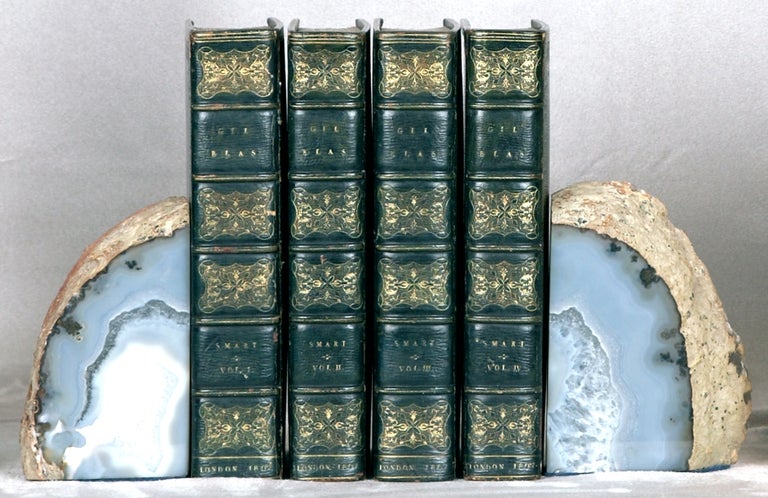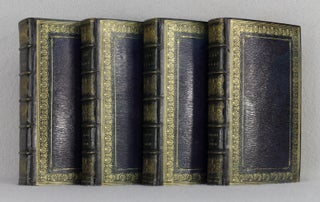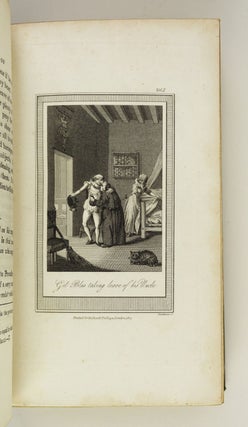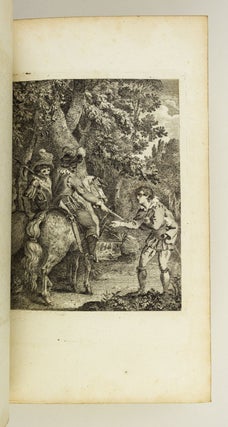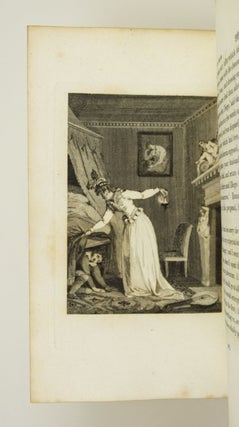THE ADVENTURES OF GIL BLAS OF SANTILLANA.
(London: Printed for Richard Phillips, 1807). 203 x 121 mm. (8 x 4 3/4"). Four volumes. Translated by Martin Smart.
EXTREMELY PLEASING CONTEMPORARY DEEP BLUE STRAIGHT-GRAIN MOROCCO, HANDSOMELY GILT, BY SAMUEL WELCHER (with his ticket on verso of front endpaper), covers bordered in gilt with triple rules and framed with wide palmette roll, inside of which is a rule with small ring and floral tools at corners; raised bands, spines ornately gilt in lobed compartments featuring stippled ground, quatrefoil centerpiece with delicate foliate sprays at sides and fleurons at ends, turn-ins gilt with single rule and fleuron and ring tools at corners, all edges gilt. WITH 160 ENGRAVINGS, comprised of 100 copperplates by Warner, Tomlinson, and others, and EXTRA-ILLUSTRATED with 60 plates by Conrad Martin Metz. Front pastedowns with armorial bookplate of H. Holland Edwards, Pennant Ereithlyn, North Wales. Lowndes II, 1343; Graesse IV, 174. ◆Front joints just a little flaked, backstrips slightly sunned, covers with minor variation in color, several plates a little foxed (generally only in margins and more frequently on added plates), one leaf with light ink stain in lower margin, light dampstain in margin at head of one plate, isolated very minor marginal soiling, but A VERY PLEASING SET, the decorative bindings very well preserved, and internally clean, fresh, and bright.
Staggemeier and Welcher were in partnership in London from about 1799 to 1810, and their bindings are normally found signed with both of their names, rather than with one name or the other, as in the present case. Like Kalthoeber and other immigrant German members of their trade, the two came to England to satisfy the fashionable need among gentry and nobility for elegant bindings, and "in their heyday Staggemeier and Welcher were one of the most prolific workshops producing 'extra' quality work in London." (Maggs Catalogue 1212) They were known for bindings with typically tasteful and often elaborate gilt decoration, and they were among the very best at producing these highly finished volumes. Howe gives evidence that at various times Staggemeier and Welcher worked together and separately at 11 and 12 Villiers Street. The assumption is that even when they were in partnership, each of the binders did at least some work of his own, but bindings signed by one of them are much scarcer than those signed by both. The illustrations in our volume are a source of interest in that the 60 by Metz depict scenes from the text that are also shown in corresponding plates by the other artists, though with a style that is dramatically different. In the engravings by Metz, there are settings with larger, more prominent figures whose dimpled knees and large round faces lend an air of comic farce to the scenes. This is perhaps more in keeping with the picaresque quality of the novel than the refined, cool, and professional engravings of the other artists, who have produced rather small figures that seem to be dwarfed by oversized settings. Le Sage (1668-1747) began his literary career translating Spanish works and thus came to appreciate the form, pioneered in Spain, of the picaresque novel, recounting the adventures of a likable rogue and satirizing the foibles of the times. In middle age, he turned to creating his own theatrical works and novels, and his acknowledged masterpiece is "Gil Blas." The story is set in Spain, and the feckless hero suffers many adventures and essays several careers (physician, courtier) before he learns compassion and achieves tranquility in a countrified life. (ST10577)
Price: $1,250.00

